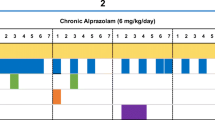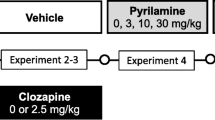Abstract
Effects of flurazepam and its two principal metabolites, hydroxyethylflurazepam and desalkylflurazepam (0.5, 1.0, 3.0 and 10.0 mg/kg), were studied on a delayed differentiation task in the monkey. Flurazepam (10.0 mg/kg) and hydroxyethylflurazepam (3.0 and 10.0 mg/kg) decreased the number of correct responses and increased response latency; effects persisted to 4 h with the highest dose. Marked impairment of performance was observed with all doses of desalkylflurazepam and effects of 3.0 and 10.0 mg/kg persisted to 24 h. Evidence of a disinhibitory effect of desalkylflurazepam was demonstrated. The study would point to a consideration of both metabolites in the hypnotic effect and in the impairment of performance observed after acute ingestion of flurazepam in man.
Similar content being viewed by others
References
Aderjan R von, Fritz P, Mattern R (1980) Zur Bedeutung des Nachweises und der Pharmakokinetik von Flurazepam-Metaboliten in menschlichem Blut. Arzneim-Forsch 30:1944–1947
Amrein R, Bovey F, Cano JP, Eckert M, Ziegler WH, Coassolo PH, Schalch E, Burckhardt J (1983) Pharmacokinetics and pharmacodynamics of flurazepam in man. Part II. Investigation of the relative efficacy of flurazepam, desalkylflurazepam and placebo under steady state conditions. Drugs Exp Clin Res IX:85–99
Anscombe FJ (1961) Examination of residuals. Proc 4th Berkeley Symp Math Statist Prob 1:1–36
Bixler EO, Kales A, Tan TL, Kales J (1973) The effects of hypnotic drugs on performance. Curr Ther Res 15:13–24
Bond AJ, Lader MH (1973) The residual effects of flurazepam. Psychopharmacologia 32:223–235
Borland RG, Nicholson AN (1975) Comparison of the residual effects of two benzodiazepines (nitrazepam and flurazepam hydrochloride) and pentobarbitone sodium on human performance. Br J Clin Pharmacol 2:9–17
Box GEP, Cox DR (1964) An analysis of transformations. J R Statist Soc B 26:211–252
Cannizzaro G, Nigito S, Provenzano PM, Vitikova T (1972) Modification of depressant and disinhibitory action of flurazepam during short term treatment in the rat. Psychopharmacologia 26:173–184
Dantzer R (1977) Behavioural effects of benzodiazepines: A review. Biobehav Rev 1:71–86
De Silva JAF, Strojny N (1971) Determination of flurazepam and its major biotransformation products in blood and urine by spectrophotofluorometry and spectrophotometry. J Pharm Sci 60:1303–1314
Dunnett CW (1955) A multiple comparison procedure for comparing several treatments with a control. Am Statist Assoc J 50:1096–1121
Dunnett CW (1964) New tables for multiple comparisons with a control. Biometrics 20:482–491
Eckert M, Ziegler WH, Cano JP, Bovey F, Amrein R, Coassolo PH, Schalch E, Burckhardt J (1983) Pharmacokinetics and pharmacodynamics of flurazepam in man. Part I. Pharmacokinetics of desalkylflurazepam and hydroxyethylflurazepam after a single intravenous injection in comparison with orally administered flurazepam. Drugs Exp Clin Res IX:77–84
Garattini S, Marcucci F, Morselli PL, Mussini E (1973) The significance of measuring blood levels of benzodiazepines. In: Davies DS, Prichard BNC (eds) Biological effects of drugs in relation to their plasma concentration. University Park Press, London, pp 211–225
Hasegawa Y, Ibuka N and Iwahara S (1973) Effects of chlordiazepoxide upon successive red-green discrimination responses in Japanese monkeys (Macaca fuscata). Psychopharmacologia 30:89–94
Hasegawa M, Matsubara I (1975) Metabolic fate of flurazepam. I. Gas chromatographic determination of flurazepam and its metabolites in human urine and blood using electron capture detector. Chem Pharm Bull 23:1826–1833
Heise GA, Laughlin N, Keller C (1970) A behavioural and pharmacological analysis of reinforcement withdrawal. Psychopharmacologia 16:345–368
John JA, Quenouille MH (1977) In: Experiments: Design and analysis, 2nd edn. Griffin, London, pp 263–264
Kaplan SA, de Silva JAF, Jack ML, Alexander K, Strojny N, Weinfeld RE, Puglisi CV, Weissman L (1973) Blood level profile in man following chronic oral administration of flurazepam hydrochloride. J Pharm Sci 62:1932–1935
Konorski JA (1959) A new method of physiological investigation of recent memory in animals. Bull Acad Polon Sci 7:115–117
Margules DL, Stein L (1968) Increase of “antianxiety” activity and tolerance of behavioural depression during chronic administration of oxazepam. Psychopharmacologia 13:74–80
Nicholson AN, Wright CM, Ferres HM (1973) Impaired performance on delaved matching in monkeys by heptabarbitone, pentobarbitone sodium and quinalbarbitone sodium. Neuropharmacology 12:311–317
Nicholson AN, Wright CM (1974) Inhibitory and disinhibitory effects of nitrazepam, diazepam and flurazepam hydrochloride on delayed matching behaviour in the monkey (Macaca mulatta). Neuropharmacology 13:919–926
Randall LO, Kappell B (1973) VIII. Metabolites of flurazepam. In: Garattini S, Mussini E, Randall LO (eds) The benzodiazepines. Raven Press, New York, pp 45–48
Randall LO, Schallek W, Scheckel CL, Stefko PL, Banziger RF, Pool W, Moe RA (1969) Pharmacological studies on flurazepam hydrochloride (RO 5-6901), a new psychotropic agent of the benzodiazepine class. Arch Int Pharmacodyn Ther 178:216–241
Roth T, Kramer M, Lutz T (1977) The effects of hypnotics on sleep, performance, and subjective state. Drugs Exp Clin Res 1:279–286
Sahgal A, Iversen SD (1980) Recognition memory, chlordiazepoxide and rhesus monkeys: some problems and results. Behav Brain Res 1:227–243
Schallek W, Kuehn A, Kovacs J (1972) Effects of chlordiazepoxide hydrochloride on discrimination responses and sleep cycles in cats. Neuropharmacology 11:69–79
Schwartz MA, Postma E (1970) Metabolism of flurazepam, a benzodiazepine, in man and dog. J Pharm Sci 59:1800–1806
Veldkamp W, Straw RN, Metzler CM, Demissianos HV (1974) Efficacy and residual effect evaluation of a new hypnotic, triazolam. J Clin Pharmacol 14:102–111
Wedeking PW (1969) Disinhibition effect of chlordiazepoxide. Psychonom Sci 15:232–233
Author information
Authors and Affiliations
Rights and permissions
About this article
Cite this article
Bradley, C.M., Nicholson, A.N. Flurazepam hydrochloride and its principal metabolites: Behavioural studies in the monkey (Macaca mulatta). Psychopharmacology 82, 395–399 (1984). https://doi.org/10.1007/BF00427693
Received:
Accepted:
Issue Date:
DOI: https://doi.org/10.1007/BF00427693




